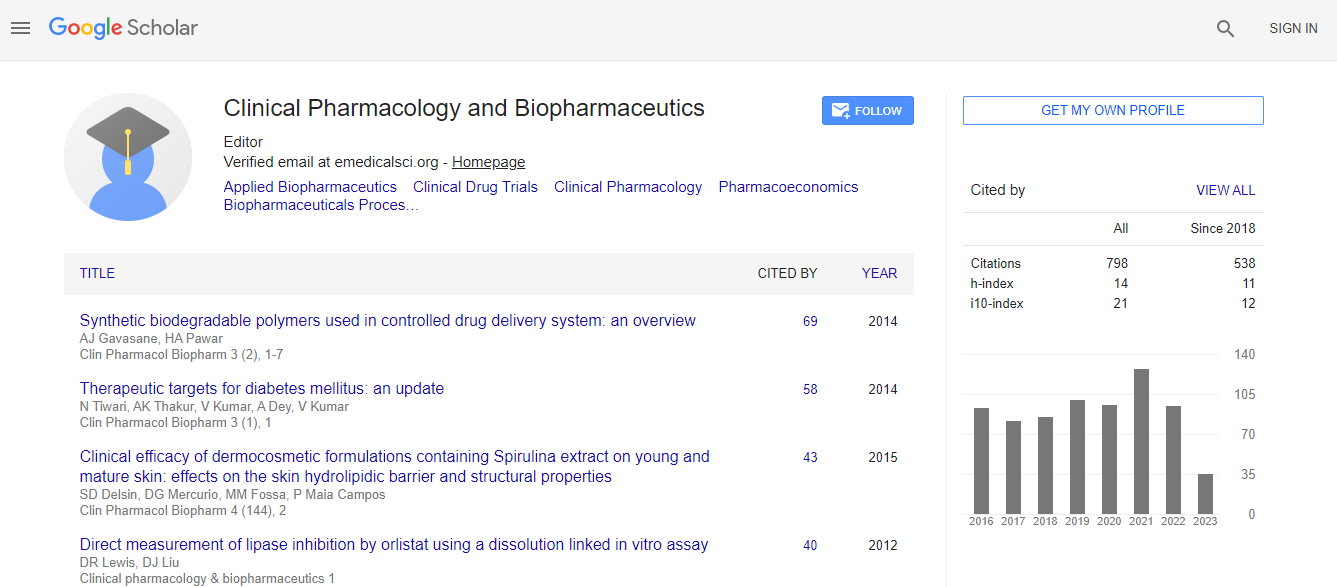Our Group organises 3000+ Global Conferenceseries Events every year across USA, Europe & Asia with support from 1000 more scientific Societies and Publishes 700+ Open Access Journals which contains over 50000 eminent personalities, reputed scientists as editorial board members.
Open Access Journals gaining more Readers and Citations
700 Journals and 15,000,000 Readers Each Journal is getting 25,000+ Readers
Google Scholar citation report
Citations : 1089
Clinical Pharmacology & Biopharmaceutics received 1089 citations as per Google Scholar report
Clinical Pharmacology & Biopharmaceutics peer review process verified at publons
Indexed In
- CAS Source Index (CASSI)
- Index Copernicus
- Google Scholar
- Sherpa Romeo
- Genamics JournalSeek
- RefSeek
- Hamdard University
- EBSCO A-Z
- OCLC- WorldCat
- Publons
- Euro Pub
- ICMJE
Useful Links
Recommended Journals
Related Subjects
Share This Page
Adherence degree assessment in pediatric patients admitted in referenced emergency unit
3rd International Conference on Clinical Pharmacy
Cinthia Madeira de Souza, Daniele Baldini, Rachel Alvarenga Queiroz, Marcelo C Reis, Priscila Gava Mazzola and Patricia Moriel
University of Campinas, Brazil
Posters-Accepted Abstracts: Clin Pharmacol Biopharm
Abstract
Adherence to treatment is the degree of agreement between the behavior of a person in relation to guidelines of the physician or other healthcare professional. The aim of this study is to compare three different methods of adherence to pharmacotherapy of continuous use in pediatric patients admitted to a unit Referenced Emergency. This is a cross-sectional study, in Referenced Emergency Unit of Clinical Hospital/Unicamp. To evaluate adherence to continuous use pharmacotherapy, were used three validated questionnaires: Morisky-Green test (low, medium and high adherence score), Haynnes and Sackett test (percentage of adherence) and SMAQ (Simplified Medication Adherence Questionnaire: Adhering or non-adhering). 207 patients were attended; these patients represent 41.7% of all patients seen in Referenced Emergency Unit and 50.2% are female, with mean age 4.6�±4.1 years. Of these, 39 (18.8%) used at least one drug in continuous regimen. The drugs most commonly used had been poly-vitamin (5; 12.8%), ferrous sulfate (4; 10.3%) and amoxicillin (4; 10.3%). Regarding degree of adherence measured by Morisky-Green test, 25.6% had high, 43.6% medium and 30.8% low adherence. In Haynnes and Sackett test, the range obtained was 42.9 to 100%. In SMAQ, 43.6% answered as adherent and 56.4% non-adherent. According to this results, there seen a difference between the instruments and demonstrates that there is a significant incidence of failures in drug administration. It emphasizes the importance of clinical pharmacist to guide the correct use of drugs, aimed at safety and efficacy of patient care and lower costs for public health system.Biography
Email: cinthiacms@gmail.com

 Spanish
Spanish  Chinese
Chinese  Russian
Russian  German
German  French
French  Japanese
Japanese  Portuguese
Portuguese  Hindi
Hindi 
